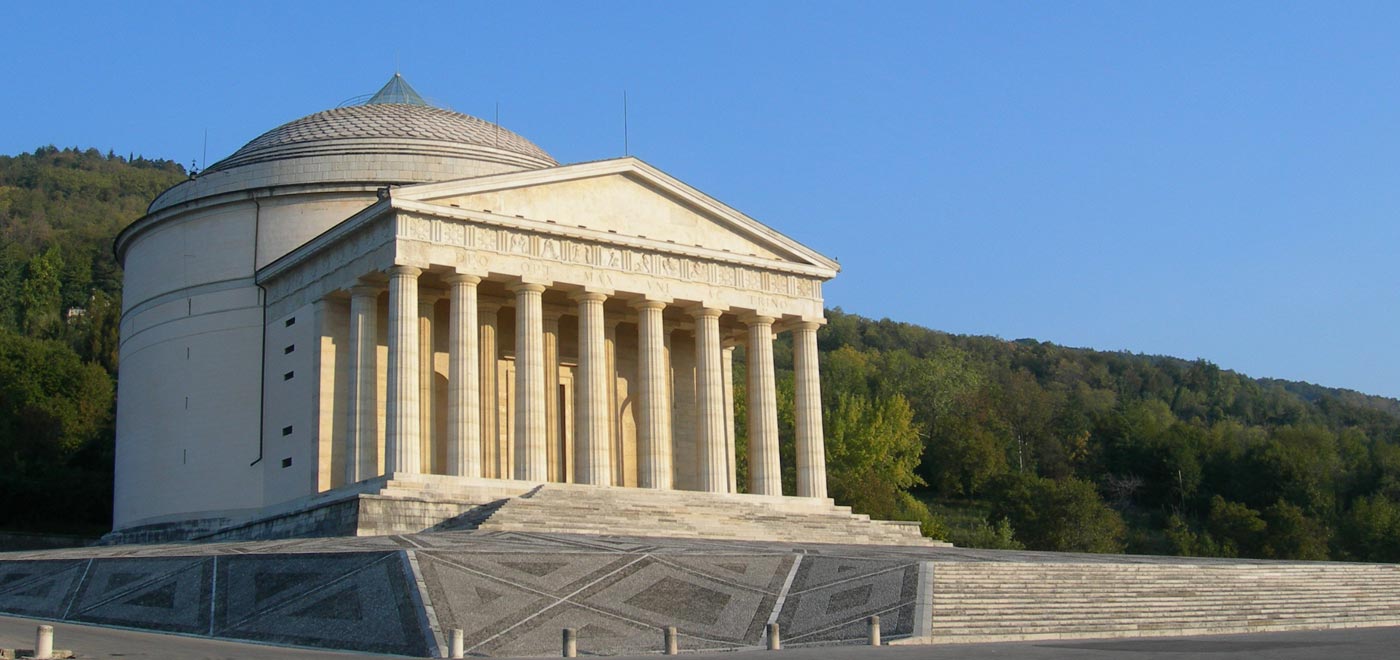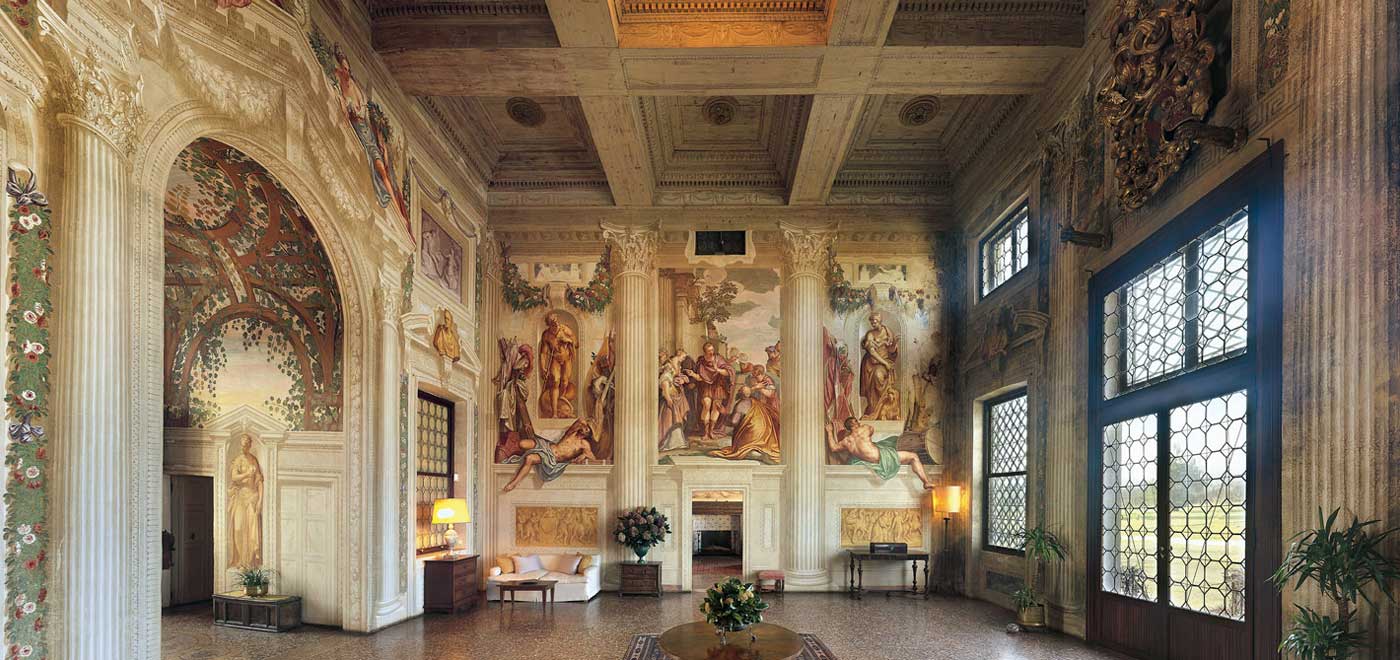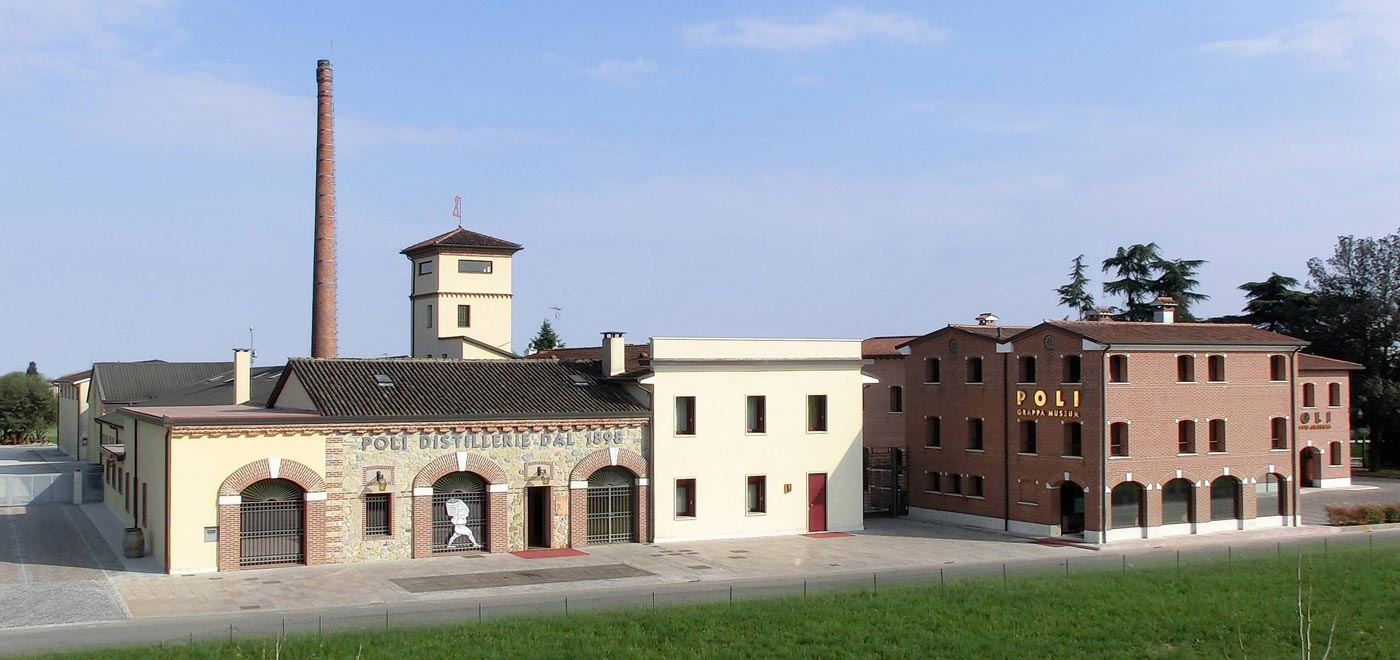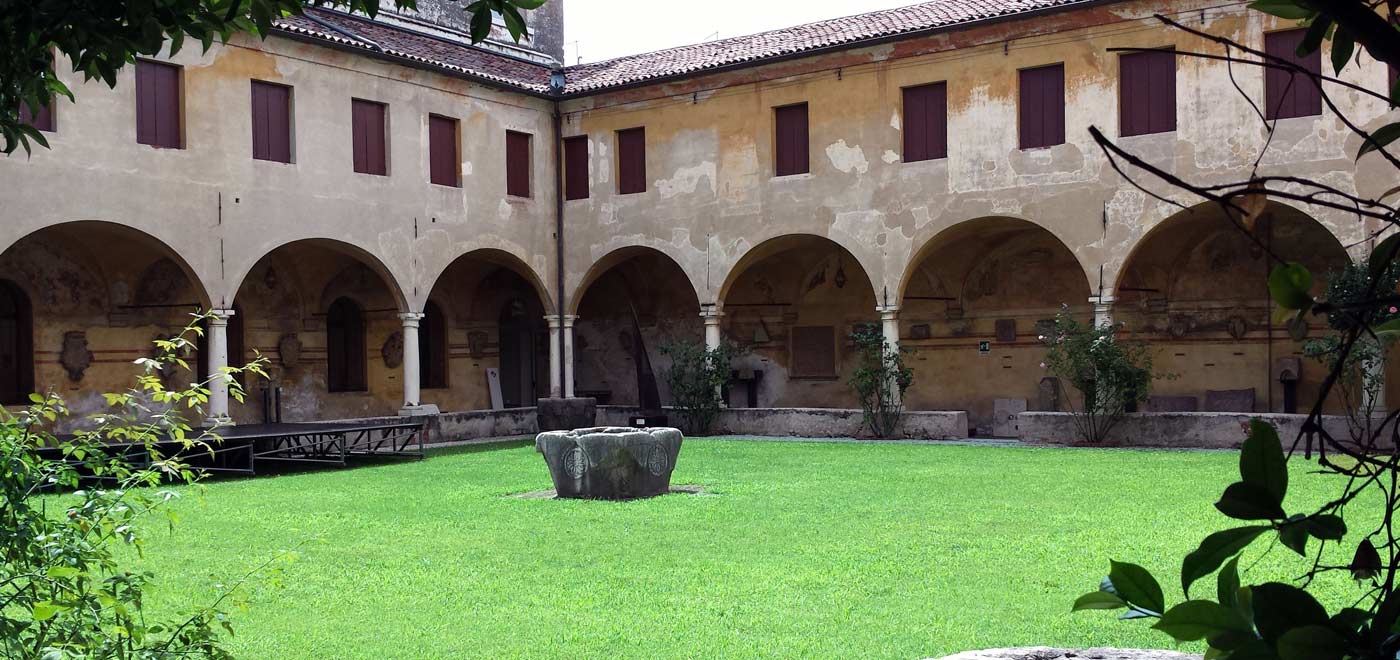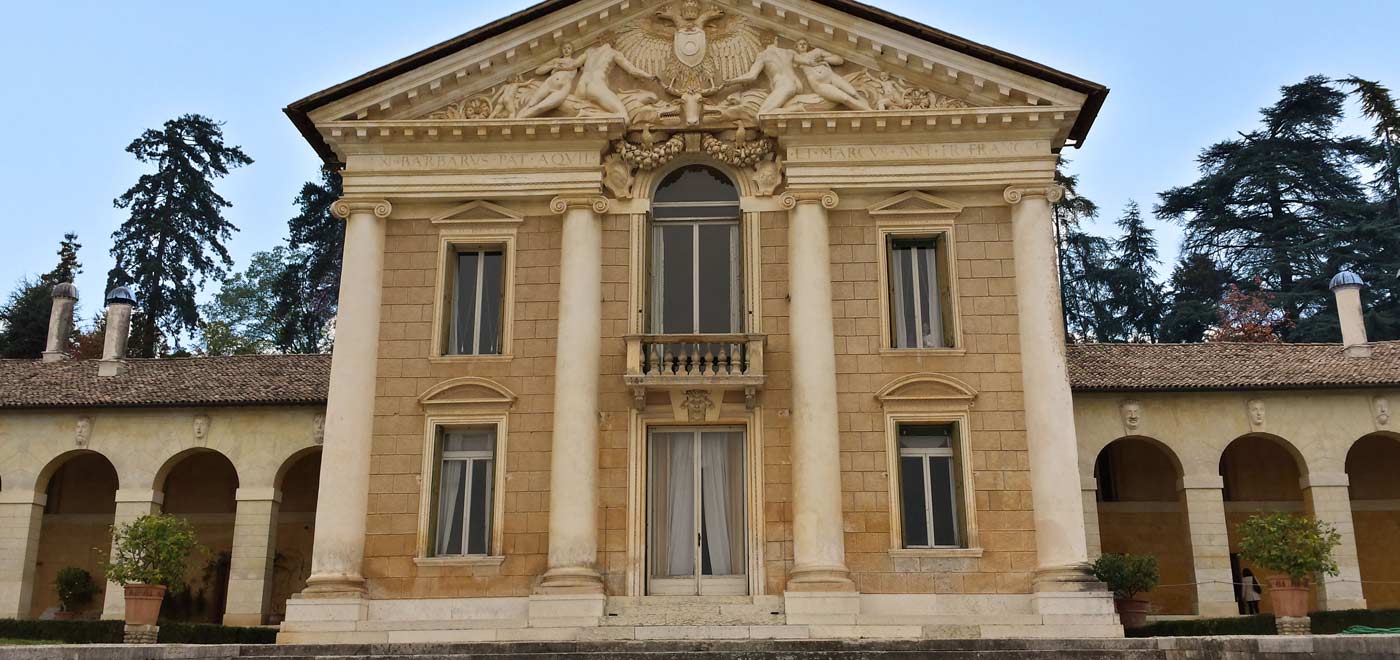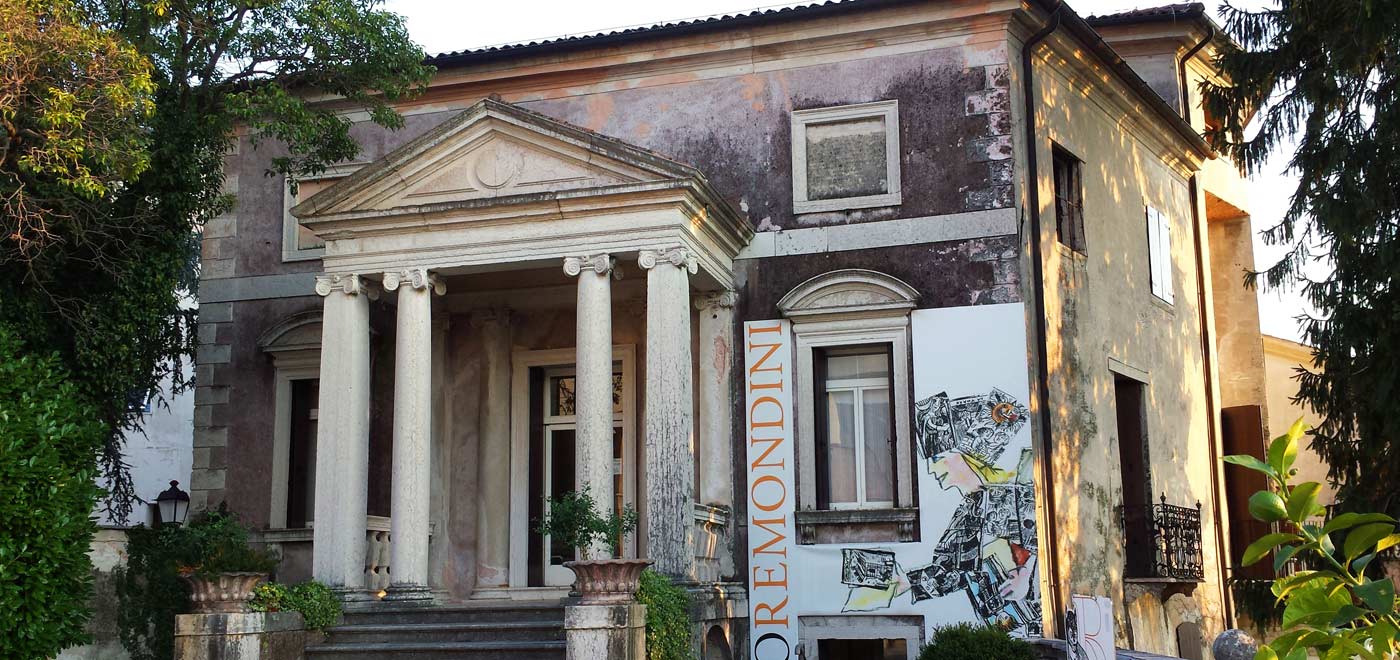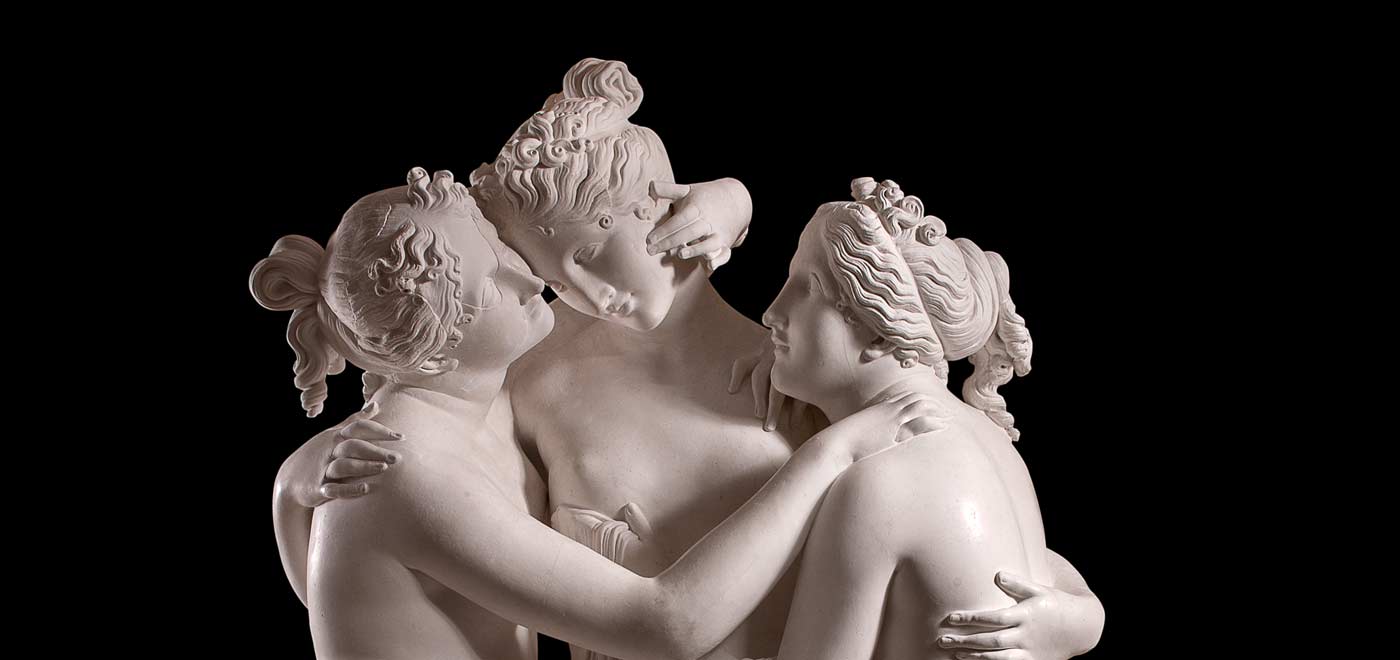History, artists, museums and historic sites in the Grappa area
The foothills of Grappa and the surrounding areas have always been home to worldwide renowned artists. Just think of some great characters who were born in these lands: Jacopo Da Ponte, Andrea Palladio, Antonio Canova, Giorgione. A tour of local museums and churches will bring the visitor to discover some artistic jewels worthy of the great European museums.
The Artists
Antonio Canova, the leading representative of Neoclassicism and one of the most famous artists of his time. A sculptor born in Possagno in 1757, Canova became an important figure in the political relations of the time (he was often invited to Rome by the Pope). In his native country, we find the beautiful Gipsoteca (plaster cast gallery) set up in his birthplace, with a large collection of his plaster models, paintings and sketches. Canova left to his beloved town the church, a majestic Temple, which was completed by his brother after his death. Here is remains are still resting today.
Andrea Palladio, renowned Renaissance architect (Padua 1508 - Maser 1580), was the supreme representative of this discipline under the Republic of Venice. In this territory, he built his famous villas, which are now part of the UNESCO World Heritage List. Villa Barbaro in Maser and Villa Emo in Vedelago are the closest Villas to Monte Grappa, residences of the lords of the Serenissima who moved to the inland. The old town of Vicenza, then, is just half an hour away from the Grappa and will fascinate the visitor with the Palladian Basilica and the Duomo. Even the famous Bassano Bridge was designed (in one of the various versions of its troubled history) by this architect.
Jacopo Da Ponte (also known as Jacopo Bassano), a painter who lived in the 1500, was originally from Bassano del Grappa. The Civic City Museum houses the largest collection in the world of the painter’s existing works and a rich documentation regarding the activity of his workshop, where he worked with his father and brother first and with his children later.
Giorgione, originally from Castelfranco Veneto, lived between the end of 1400 and the beginning of the 15th century. Already famous while still alive, he remains a mysterious figure in the pictorial world. Some of his works can be admired at the museum set up at his birthplace and inside the adjacent Duomo di Castelfranco.
Museums and historic sites
Bassano del Grappa (VI)
-

Civic Museum
Civic Museum
Location: Piazza Garibaldi 34
Description: the Civic Museum is one of the oldest ones in Veneto: it was founded in 1828 following the legacy of the naturalist Giambattista Brocchi. Originally planned as a mix between a museum, a library and an archive, in 1840 it found its current location inside the former Convent of the Church of St. Francis. From that date, collections of natural history and books left by Brocchi (herbs, geopaleontological, mineralogical, malacological and entomological collections) have been conserved here, as well as some paintings, already present in the rooms adjacent to the cloister of St. Francis, since 1831. Over the years, the entire heritagehas been exceptionally enriched: today it is possible to admire and study only one part, set up in the archaeological sections (paleolithic, magnogreca, roman and medieval finds), in the pinacoteca (pictorial works from the XIII to XX century), in the cloister (lapidary of memorial steles, coats of arms, inscriptions, tomb stones and architectural fragments from the thirteenth century). In particular, the pinacoteca houses over 500 paintings, among which is the largest collection in the world of Jacopo da Ponte's existing works and a rich documentation of the activity of his workshop. The Canova section collects three thousand autographed drawings, the epistle, the library, the sketches, numerous plaster and the unique monochrome series.
Contact: +39 0424 519901 info@museobassano.it
-

Remondini Museum and Ceramics Museum
Remondini Museum and Ceramics Museum
Location: In Palazzo Sturm, via Schiavonetti 7
Description: In the six halls of the section dedicated to the famous printing house, the Remondini, the story of their productions is carefully preserved. Books, decorated cards, sacred and profane popular engravings, cut-outs, card games, optics, watercolors and xylographs of the great Italian and European engravers, (including Mantegna, Dürer, Canaletto and Tiepolo) from the mid-17h to mid-19th century can be seen here. The museum, one of the few in Italy dedicated to this art form, also houses temporary exhibitions dedicated to old and contemporary prints. The section of the building dedicated to the ceramic exposes a collection of more than 1200 pieces of tiles, porcelain and pottery. They are placed chronologically, starting with the oldest pieces of medieval ceramics in Manardi majolica (XVII-XVIII century). The most significant heritage is represented by the production of Antonibon (XVIII-XIX century) and its majolica, porcelain and terraglia. The large patio offers an appropriate frame for eclectic tiled tiles, while the old kitchen houses the "Vergani" and "Mazzotti" collections, examples of popular art. The lower floor collects the contemporary works of internationally renowned artists.
The two museums are hosted inside Palazzo Sturm, a splendid eighteenth-century mansion that welcomes visitors with an Ionian pronaos and a salon of honor frescoed in 1765 by Veronese Giorgio Anselmi. The dense stucco details inside some of the rooms is one of the most important rococo decoration in Veneto.
Contact: +39 0424 519940 info@museobassano.it
-

Civic Tower
Civic Tower
Location: Piazza Garibaldi
Description: Built in the mid 13th century, or more probably at the beginning of the '300, by the Da Romano family, the tower stands out over the city with its 43 metres. It was completed with a clock during the 18th century.
Contact: +39 371 1122121 - torrecivicabassano@gmail.com
-

Zoological Section of the Civic Museum
Zoological Section of the Civic Museum
Location: Palazzo Bonaguro, via Angarano 77
Description: The palace hosts the zoological section of the Civic Museum. Since 2006, the museum also hosts a collection of zoological specimens in Palazzo Bonaguro, donated by the Cites Service of the State Forestry Corps and now part of the exhibition “Animal world, know it to protect it”.
Contact: +39 0424 502923 - 519901 info@museibassano.it
-

Poli Museum of Grappa Spirit
Poli Museum of Grappa Spirit
Location: Via Gamba, 6 (near Ponte Vecchio)
Description: the Poli Grappa Museum, in a sumptuous and evocative space, tells the story of distillation and the history of Grappa spirit presented through a brief but exhaustive educational path. You can also visit the headquarters of the Poli distilleries, located in Schiavon, about 13 km from Bassano.
Contacts: +39 0424 524426 www.grappa.com
Romano d’Ezzelino (VI)
-

Automobile Museum Bonfanti Vimar
Automobile Museum Bonfanti Vimar
Location: Via Torino, 2
Description: The automobile museum "Bonfanti-Vimar" was established 20 years ago and is located on the northern outskirts of Bassano. It is internationally renown for being the first to implement a unique and innovative exhibition philosophy. Every six months, in Spring and Autumn, the museum completely changes its content, proposing each time a different theme. The innovative museum is very active and organizes courses for vintage vehicle restorers, an art form otherwise destined to disappear together with the oldest craftsmen. For the varied cultural proposals, the Automobile Museum "Bonfanti-Vimar" was awarded with the Trophy of the Best European Museum of Motorization in 1999, 2000, 2001, 2004 and 2007.
Contacts: +39 0424 513690 www.museobonfanti.veneto.it
Possagno (TV)
-

Canova Museum and Gipsoteca
Canova Museum and Gipsoteca
Location: Via Canova, 74
Description: In the small hometown of the greatest representative of neoclassicism, the sculptor Antonio Canova, lies this interesting museum. It includes the sculptor’s birthplace and the adjacent Gipsoteca, built in 1836, which collects almost all the original patterns of its sculptures, terracotta sketches, drawings and paintings. The Canova Foundation regularly updates information about exhibitions and initiatives on its website.
Contact: +39 0423 544323 www.museocanova.it
-

Canovian Temple
Canovian Temple
Location: Via Stradone del Tempio
Description: The Temple was designed by Antonio Canova between 1804 and 1818. He was particularly concerned about the achievement of the project and supported almost entirely the construction costs. He considered it a gift to his native citizen and his community. He died in 1822, only three years after the laying of the first stone, leaving his brother, Monsignor Giovanni Battista Sartori, to ensure the work would have been completed. The temple was consecrated to the Trinity in 1832. It is a pure neoclassical construction with a colonnade recalling the Parthenon of Athens and a central body that resembles the Roman Pantheon. The apse of the higher altar recalls the greatness of Christianity. Within the Temple, rest the remains of Canova and his brother Sartori.
Contact: +39 339 6548000 www.prolocopossagno.com
Castefranco Veneto (TV)
-

Home of Giorgione Museum
Home of Giorgione Museum
Location: Piazza San Liberale
Description: The museum is set up inside the house where the famous painter, born in Castelfranco between 1477 and 1478, painted the enigmatic frieze of the liberal and mechanical arts. Just a few meters away from the house you will find the Duomo, which hosts the “Pala”, a painting representing the Virgin Mary with Child between Saint Francis and Saint Nicasio. Embracing the three main elements for which the museum was designed - the Pala of Castelfranco, the Fregio and the House itself - are more than 100 original pieces. Inisde this museum house, personal objects of Giorgione are displayed. They come from the civic collection or have been acquired on the antique market. Architectural reconstructions have been made inside the house with the contribution of contemporary artists, to offer the visitor a strong suggestion of the culture of the time.
Contact: +39 0423 725022 www.museocasagiorgione.it
Asolo (TV)
-

Asolo Civic Tower
Asolo Civic Tower
Description: The Civic Tower, or Clock Tower, is one of the four towers of the Asolo Castle. The defensive building, known from sources since the tenth century, stands on a rocky spur located south-west of the Asolo hills. The clock, whose gears are visible on the third floor, was installed in 1750 and is the work of the famous clock-builder Bartolomeo Ferracina. Climbing the 105 steps it is possible to enjoy a splendid view of the historic center and the surroundings of Asolo, from the mountains to the sea.
Contact: +39 0423 952313 / +39 347 5735246 - info@museoasolo.it
Opening hours (1st November - 28th February): Saturday and Sunday from 10am to 5pm
Opening hours (1st March-31st October): Saturday and Sunday from 10am to 7pm
Ticket cost: € 2 per person -

Civic Museum
Civic Museum
Location: Via Regina Cornaro, 74
Description: The current Civic Museum occupies, besides the near Palazzo del Vescovado, the building of the Loggia della Ragione. The Loggia was formerly a palace for the Town Hall back in the 14th century, built to accommodate the representatives of the City Council and the Magnificent Community of Asolo. It was frescoed around the half of the 16th century. The first museum collection was formed at the beginning of the nineteenth century thanks to the donations of Bartolomeo Fietta, Domenico Manera and Giovanni Battista Sartori (brother of the sculptor Canova). At the end of the century, the Museum was officially established at the then Municipal Hall of the Loggia della Ragione, and gradually enriched by the legacies of Andrea Manera and Pacifico Scomazzetto. From the beginning of the twentieth century, the donations intensified, greatly increasing the artistic and historical heritage of the institute. The recent refurbishment hosts the Archaeological Section (ground floor), the Pinacoteca (first floor), the Caterina Cornaro Section, the Treasury of the Cathedral, the Eleonora Duse and Freya Stark Section (second floor).
Contact: +39 0423 952313 / +39 347 5735246
info@museoasolo.it - www.museoasolo.it -

Roman aqueduct “la Bot”
-

Rocca - FORTRESS
Rocca - FORTRESS
Description: A majestic medieval building that dominates the town from the top of Monte Ricco offering a panoramic view from mount Grappa to the bell towers of Venice and the gentle hills of Asolo and Valdobbiadene. The walk to reach the fortress starts from the historic center and it is very suggestive.
Contact: +39 0423 952313 / +39 347 5735246 - info@museoasolo.it
-

Duomo
Duomo
Description: Built in the 17th century, it hosts the Assumption of Lorenzo Lotto and many other works of art.
Contact: For further information on interesting sites in Asolo please visit www.asolo.it or contact the IAT office +39 0423 529046 iat.asolo@provincia.treviso.it
Montebelluna (TV)
-
Boot Museum
Boot Museum
Location: Villa Zuccareda Binetti, Vicolo Zuccareda 5
Description: The sumptuous setting of the sixteenth-century Villa Zuccareda Binetti, theater to many episodes of the Italian history, hosts the Boot Museum. Montebelluna and its hinterland have been devoted for decades to produce technical footwear. The representation of this 'sports district' is found in the path between the halls of this museum that traces the history of footwear from the nineteenth century to the present days.
Contact: +39.0423.303282 www.museoscarpone.it
-

Museum of Archeology and Natural History
Museum of Archeology and Natural History
Location: Villa Biagi, Via Piave 51
Description: Sixteenth-century Villa Biagi hosts this Museum. The barchessa (colonnade) has been destined for exhibition, while the rooms of the villa are used as offices, conference rooms, documentation centers, classrooms and didactic laboratories. The museum is divided into two sections: a naturalist section divided into two subsections (Earth Sciences: 5 halls, and Life Sciences: 6 halls) and an archaeological section divided into two subsections (Prehistoric- Veneti Antichi and Roman Era). There is also a third detached section that is located in Schievenin di Quero (BL).
Contact: +39.0423.300465 www.museomontebelluna.it
Crocetta del Montello (TV)
-

Civic Museum Earth and Man
Civic Museum Earth and Man
Location: Via Erizzo 133
Description: The exhibition path of the Museum of Natural History is essentially didactic. It develops the history of life on our planet in four major moments: the evolution of life from the origins to the appearance of mammals, the evolutionary theories of the Homo, the great quaternary mammals of our region (the mammoth) and the history of man through his discoveries.
Contact: +39 0423 86232 www.ecomuseoglobale.it
Cornuda (TV)
-

Museum of typeface and typography
Museum of typeface and typography
Location: Via del Canapificio, 3
Description: Founded in 2002 from an idea of the Antiga brothers, holders of the homonymous printing company and founders of the TIF (Tipoteca Italiana Foundation), the museum is a multifaceted space dedicated to typography and print typeface. A route between exhibition halls and equipped workshops flows inside the buildings of the former Canapificio Veneto, a major site of industrial archeology.
Contact: +39 0423 86338 www.tipoteca.it
Maser (TV)
Vedelago (TV)
-

Villa Emo
Villa Emo
Location: Via Stazione 5, frazione Fanzolo
Description: The Villa, bound to the Emo Family since its construction in 1558 and until 2004, is a masterpiece designed by architect Andrea Palladio. It has been added by UNESCO to the list of World Heritage Sites. It is one of the most accomplished works of the famous architect, who had already been building similar villas during the previous twenty years. The interior rooms were frescoed by painter Giovanni Battista Zelotti. On both sides of the central body of the villa are two long colonnades, while the whole complex is immersed in the green of a magnificent garden.
Contact: +39 0423 476334 www.villaemo.org
Valbrenta (VI)
-

Grotte di Oliero
Grotte di Oliero
Location: Via Oliero di Sotto, frazione Oliero
Description: The Oliero caves represent the most important water drainage system of the entire plateau of Asiago. The water that filters thanks to the karstic nature that characterizes the Plateau has created an impressive underground water system. From the caves originate the springs of the Oliero River, a tributary of River Brenta, which are one of the main examples of "Valchiusan springs" in Europe.
Contact: +39 0424 99813 www.grottedioliero.it
-

Museum of Speleology and Carsism “Alberto Parolini”
Museum of Speleology and Carsism “Alberto Parolini”
Location: Via Oliero di Sotto, at the entrance of Oliero Cave Park
Description: Dedicated to the naturalist Alberto Parolini, founder of the park, the museum provides details about speleogenesis and karstic phenomena, as well as about archeology, speleology and geology.
Contact: +39 0424 99983
-

Ethnographic museum “Canal di Brenta”
Ethnographic museum “Canal di Brenta”
Location: Via G. Garibaldi 27, presso Palazzo Perli
Description: The museum was set up to give ethnographic reconnaissance to Valstagna and the Brenta Valley. The collection of the exhibited material derives from the full transcript of interviews, oral testimonies, as well as the collection and cataloging of popular tools that testify to traditional customs. It explores different local activities, from breeding to tobacco cultivation, from the terraces called "masière" to the rafts on the Brenta river.
Contact+39 0424 99891 www.museivalstagna.it
Cartigliano (VI)
-

Cappeller Faunistic Park
Cappeller Faunistic Park
Location: Via Kimle
Description: 40,000 square meters wide, the park hosts many animal species and an appreciable botanical garden. You can also visit the museum dedicated to the evolution of man and animals.
Contact: +39 0424 592513 www.parcocappeller.it
Nove (VI)
-

Pottery Museum
Pottery Museum
Located: Piazza De Fabris, 5
Description: Opened in 1995, the Museum is an expression of the ancient ceramic tradition of Nove. The collection, divided by epochs, extensively records the history of Veneto ceramics, particularly that made in Nove and Vicenza, from the '700 to the present days, as well as presenting some interesting objects from previous periods.
Contacts +39 0424 829807 museo@comune.nove.vi.it - www.ceramics.it/museo.nove

